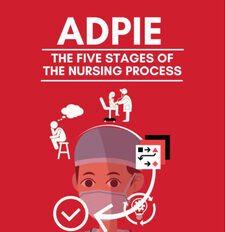

● Individualized tutoring.
● 1 hour free consultation for prospective students (applicable to senior students in their final year of nursing school and students who have failed their NCLEX examination. The hourly rate will be $50/hr.
NCLEX® Examination Candidate Bulletin ● NCSBN
What Is the Nursing Process?
The five phases are…
Assessment:
When you first encounter a patient, you will be expected to perform an assessment to identify the patient’s health problem(s) as well as their physiological, psychological, and emotional state. To do this, you will typically conduct an interview and take patient vitals. To make sure the information you collect is easily referenced by others, you will note all parts of your assessment in the patient’s chart.
 Diagnosis:
Diagnosis:Once you’ve completed your assessment, you will take all the gathered information into consideration and diagnose the patient’s condition and medical needs. This doesn’t mean you identify a specific disease or ailment. Rather, your diagnosis will identify a general cause of symptoms (e.g., constipation, hypothermia, anxiety) and/or any risks the patient faces (e.g., shock, stroke, tissue death).
Planning:
Once you, any supervising medical staff, and the patient agree on the diagnosis, you will plan a course of treatment that takes into account short-term and long-term goals. Most treatment plans will include interventions conducted by the medical staff (e.g., suturing, medication prescription, IV fluids) followed by steps taken by the patient to ensure proper recovery.
Implementation:
Implementation is when you put the treatment plan into effect. This typically begins with the medical staff performing any needed medical interventions. Then, the patient follows the plan for optimum recovery. As a nurse, you will be expected to monitor the implementation to ensure the patient is following through. If they aren’t — or if the follow-through is ineffective — you’ll want to reevaluate the plan.
Evaluation:
We learn what works and what doesn’t by evaluating what we’ve done previously. As such, evaluation is the last, but in no way least, important step in ADPIE. Once a patient completes their treatment, you and the rest of the medical staff should review the steps taken, determine whether they worked as expected, and identify any problems that can be corrected in the future.
 What is ADPIE?
What is ADPIE?
ADPIE is an acronym representing the five phases of the nursing process Resources: The 5 Steps in the ADPIE Nursing Process ● Walden University
The Nursing Process and Patient Teaching ● Lippincott https://lww.com/pages/default.aspx
The Five Step Nursing Process ● Indeed.com https://www.indeed.com/career-advice/career-development/nursing-process
Nursing Process ● StatPearls ● NCBI Bookshelf https://www.ncbi.nlm.nih.gov
Disclaimer: While we do our best to provide students with accurate and in-depth reviews, all students are strongly encouraged to use the most current NCLEX-RN Bulletin guidelines for the assigned year, and the school’s assigned text and lecture content as primary resources.
Disclaimer: Use of the Nursing Process and learning how to integrate ADPIE in critical reading and thinking may not initially give students a perfect score (100%) on quizzes or exams, however, research has shown that after understanding of the process and its application to identified patient problems, there has been continuous improvement with students’ exams and quizzes.



